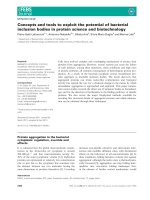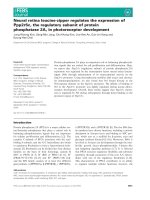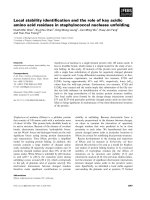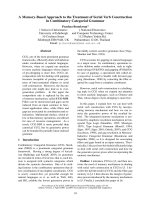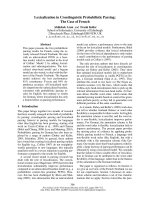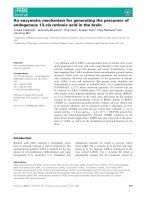báo cáo khao học 'inbreeding in pinus radiata. iv the effect of inbreeding on wood density'
Bạn đang xem bản rút gọn của tài liệu. Xem và tải ngay bản đầy đủ của tài liệu tại đây (177.32 KB, 6 trang )
H.X. Wu et al.Inbreeding effect on radiata wood density
Original article
Inbreeding in Pinus radiata.
IV: the effect of inbreeding on wood density
Harry X. Wu
*
, A. Colin Matheson and Aljoy Abarquez
CSIRO Division of Forestry and Forest Products, PO Box E4008, Kingston, Canberra, ACT 2604, Australia
(Received 5 July 2001; accepted 15 January 2002)
Abstract – The effects of inbreeding on basic wood density in a 17-year-old radiata pine trial were studied using five populations, each inbred to
one of five inbreeding levels: outcross (OC, F = 0), half-sib (HS, F = 0.125), full-sib (FS, F = 0.25), selfing (S
1
, F = 0.5) and two-generations of
selfing (S
2
, F = 0.75). These five populations were derived from a founder population of eight clones. Although inbreeding resulted in slightly
depressed wood density (inbreeding depression was 1.47%, 2.50%, 1.65%, 0.02%, respectively at F = 0.125, 0.25, 0.50 and 0.75), the effects
were not significant. However, the variation of wood density among trees was increased by inbreeding, by 3.70%, 3.40%, 15.74%, and 29.01%
respectively for populations at F = 0.125, 0.25,0.5, and 0.75. In all five populations, the basic wood density increased linearly from 400 kg m
–3
at
age 4 (the earliest age for most samples) to about 525 kg m
–3
at age 12 and stabilized with some fluctuation thereafter. There were significant dif-
ferences among pedigrees in response to inbreeding for wood density. The pedigrees can be divided into three classes according to their res-
ponse patterns to inbreeding: no decline of wood density under any inbreeding level; a linear decline from F = 0 to F = 0.75; and an initial decline
at mild inbreeding levels contrasted with an increase in selfed generations. The lack of significant inbreeding depression of wood density at the
population level combined with increased variation in wood density in the inbred populations suggests that it will be possible to quickly develop
inbred lines with high wood density. The combination of low inbreeding depression for growth with a lack of inbreeding depression for wood
density makes radiata pine a species ideally suited for the use of inbreeding as a breeding tool.
radiata pine / inbreeding depression / wood density / purging
Résumé – Consanguinité chez Pinus radiata. IV : l’effet de la consanguinité sur la densité du bois. Les effets de la consanguinité sur la den
-
sité basale du bois sont étudiés dans une expérience de pins radiata âgés de 17 ans. Cinq types de croisements (et donc niveaux de consanguinité)
sont considérés : intercroisement (OC, F = 0), croisement demi-frère (HS, F = 0,125), plein frère (FS, F = 0,25), auto-fécondation (S1, F = 0,5)
et deux générations d’auto-fécondation (S2, F = 0,75). Ces 5 populations sont dérivées d’une population fondatrice de 8 clones. Bien que la
consanguinité produise une densité du bois légèrement plus basse (la dépression de consanguinité atteignant 1,47 %, 2,50 %, 1,65 % et 0,02 %
respectivement avec un F = 0,125, 0,25, 0,50 et 0,75), les effets ne sont pas significatifs. Cependant, la variation de la densité du bois entre arbres
augmente avec le niveau de consanguinité de 3,70 %, 3,40 %, 15,74 % et 29,01 % respectivement pour les populations avec un F = 0,125, 0,25,
0,50 et 0,75. Dans les 5 populations, la densité du bois augmente linéairement de 400 kg m
–3
à l’âge de 4 ans (le plus jeune âge pour la plupart des
échantillons) à environ 500 kg m
–3
à l’âge de 12 ans ; puis elle se stabilise ensuite avec quelques fluctuations. Pour la densité du bois, des diffé
-
rences significatives entre pedigrees ont été mises en évidence en réponse à la consanguinité. Les pedigrees peuvent être répartis en 3 classes :
pas de diminution de la densité du bois quelque soit le niveau de consanguinité, une diminution linéaire de F = 0 à F = 0,75 et une diminution ini
-
tiale pour des faibles niveaux de consanguinité contrastant avec une augmentation dans les générations autofécondées. L’absence de dépression
de consanguinité significative pour la densité du bois au niveau population combinée avec l’augmentation de la variabilité de la densité du bois
dans les populations consanguines suggère qu’il est possible de développer rapidement des lignées consanguines avec du bois de haute densité.
La combinaison d’une faible dépression de consanguinité pour la croissance associée à l’absence de dépression pour la densité du bois fait du pin
radiata une espèce idéale pour l’usage de la consanguinité comme outil d’amélioration.
Pinus radiata / dépression de consanguinité / densité du bois / épuration
Ann. For. Sci. 59 (2002) 557–562
557
© INRA, EDP Sciences, 2002
DOI: 10.1051/forest:2002041
* Correspondence and reprints
Tel.: 61 26 28 18330; fax: 61 26 28 18312; e-mail:
1. INTRODUCTION
Selfing and subsequent cross breeding is a principal breed
-
ing method for the improvement of many outcrossing agro
-
nomic species [14]. There are three major advantages of
using a single-cross hybrid in crop breeding: (1) high yield;
(2) uniformity and (3) stability. (1) Inbreeding and subse
-
quent cross breeding with selected inbred lines has produced
superior growth in maize [12]. (2) Cross of two essentially
homozygous genotypes produces a uniform genotype, attrac
-
tive for its uniform appearance, maturity and harvesting char
-
acteristics. (3) As the progenies produced from single crosses
are heterozygous, the yields are more stable under variable
environments.
Selfing as a breeding tool for forest trees was first advo
-
cated three decades ago, using the experience with maize as a
justification [18]. Righter advocated the development of
selfed lines in conifers to produce hybrid seed for plantation
forestry. Wilcox [25] suggested selfing and pair-wise crosses
among the best S1 as a possible breeding strategy in the
loblolly pine (Pinus taeda) program at N.C. State University.
Lindgren [11] recommended the inclusion of S1 selection in
the outcrossing program to enhance genetic gain. However,
inbreeding followed by cross breeding still has not yet been
used as a practical breeding tool in tree improvement. There
have been three major obstacles: (1) most conifer breeding
programs in the last three decades were in their infancy and
most of their resources were devoted to assemble and evalu-
ate plus trees in the wild; (2) the long generation turnover
makes the production of inbred lines time-consuming and ex-
pensive [9, 22, 23]; (3) early experiments revealed severe in-
breeding depression in conifers, affecting seed production,
growth and adult fecundity (see Williams and Savolainen
[27] for a review). Prior to our work with radiata pine [13, 28,
29], there was no documented evidence that high quality in
-
bred lines in tree could be obtained from selfing. In particu
-
lar, there were no long-term inbreeding experiments to
provide evidence of useful heterosis in tree growth [6, 7].
Thus, early conifer breeding programs worldwide were
managed for inbreeding avoidance and relied upon open-pol
-
linated production seed orchards [27]. Sib- or random-mating
was recommended in early generations of conifer domestica
-
tion to reduce inbreeding depression in the breeding popula
-
tion. Simple recurrent selection for a single, large breeding
population was preferred at that time, today population sub
-
division strategies are more commonly used [3, 15, 24]. Re
-
cently, selfing as a breeding tool has been revived because of
the growing interest in small elite breeding populations [27]
and the possibility of purging deleterious alleles [10, 16].
Successful use of the inbreeding and cross breeding method
in trees will depend on its effectiveness in purging deleteri
-
ous alleles and in producing heterosis. Recently we observed
that it is possible to derive highly productive inbred lines in
radiata pine [28]. Data from radiata pine inbreeding trials in
-
volving five inbreeding levels revealed: (1) inbreeding
depressed mean diameter growth and survival but increased
the variance (segregation). However, continued selfing to a
second generation (S2) did not further reduce growth [28];
(2) the best trees in the trial were from two-generations of
selfing; (3) higher level of inbreeding had more segregation
for tree growth; (4) the effect of inbreeding is pedigree de
-
pendent (some pedigrees have no inbreeding depression); (5)
inbreeding affected the growth curve, and the age-trend of in
-
breeding depression was affected by competition [29]; (6)
age-age correlation increased with inbreeding level, allowing
effective early selection of selfed lines at age as young as five
and six [13].
These findings demonstrated the great potential to develop
high-quality inbred lines and produce highly productive hy
-
brids in radiata pine. In accordance with these observations,
we have established an experimental inbred population in
radiata pine to further explore the inbreeding and cross breed
-
ing method and to develop superior inbred and hybrid lines
for radiata pine. Tree improvement of radiata pine was
mainly focused on growth and form in the past. Currently,
wood quality improvement is a major focus because of the
observed decline in wood density in some elite breeding ma-
terial. Thus, characterizing the effect of inbreeding on wood
quality is timely, relevant and important for further inbreed-
ing and cross breeding work. In this paper, we report results
from an investigation of the effect of inbreeding on wood
density in a mature inbreeding trial (17 years old) and discuss
the potential effectiveness of the inbreeding and cross breed-
ing strategy for improvement of both wood quantity and qual-
ity in radiata pine.
2. MATERIALS AND METHODS
2.1. Mating design and field trial
Five populations with different inbreeding levels were created in
1970 from eight founder clones (pedigrees, figure 1). They included
558 H.X. Wu et al.
AB
C
DE
G
I
FH J
Inbreeding
level (F)
Population constitution Abbreviation
0.0
0.125
0.25
0.5
0.75
Full-sib families of unrelated parents (eg D)
Families from crosses of half sibs (eg H)
Families from crosses of full-sibs from unrelated
parents (eg F)
Families from selfing non-inbred individuals (eg I)
Families from selfing S
1
individuals (eg J)
OC
HS
FS
S1
S2
Figure 1. Generalised diagram of crossing structure to obtain differ
-
ent inbreeding levels of five populations (not all pedigrees are
shown).
outcrossed progenies (OC, F = 0, population 1) of eight unrelated
grandparents, progenies from mating of half-sib relatives (HS,
F = 0.125, population 2), progenies from mating of full-sib relatives
(FS, F = 0.25, population 3), selfed progenies from grandparents
(e.g. first-generation selfs S1, F = 0.5, population 4) and sec
-
ond-generation selfs (S2, F = 0.75, population 5). The pedigree 1
was only inbred to S1. The detailed mating design for each popula
-
tion was described before [28, 29].
A split-plot field design was used in the field trials, with inbreed
-
ing level as the main plot and families within each of five inbreeding
levels as sub-plot. A single row of six-tree sub-plot for each family
was randomized within the main plot. The trial has two sites, the
main site is in Symonds, South Australia with all five populations
planted in four replications in 1981 and the supplement site is in
nearby Kilsby (two kilometers from Symonds), with two popula
-
tions in six replications planted in 1982. In 1993, two trees were
thinned in each plot. The thinning was systematic: the second and
third trees were taken out from each six-tree row plot. After
thinning, most plots still had four trees left. However, some plots
had less than four trees and a few plots had no remaining trees,
particularly for the selfed populations. The trial had a total of 1912
surviving trees in the five populations after thinning.
2.2. Sampling of increment wood cores and assessment
of wood density
The first two remaining trees in each plot were sampled in 1997.
Since the second and third trees were felled before, this meant the
first and fourth trees were sampled where possible. If the first or
forth trees were not available (dead or replaced by a fill tree), the
next tree was sampled within each plot. Increment core samples
were collected using a 12-mm diameter tree corer at 1.30 m from the
ground. The cores were then soaked in three fresh batches of 100%
ethanol, each batch lasting at least 3 days. This process prevented
blue stain and removed surface resins from the samples. The sam-
ples were then air-dried.
A twin-bladed saw was used to cut 2-mm thick representations of
each core, one to show the cross section view and the other to show
the longitudinal view of incremental growth. The cross section cuts
of the samples were used for this study. Gravimetric densities of the
samples were estimated for calibration to WinDENDRO X-ray
densitometry scanning [19]. Any remaining resins from the samples
were then extracted in a liquid extractor filled with acetone. The
samples were then air-dried before exposure to X-ray. The X-rayed
films were scanned for density profile analyses using WinDENDRO
software [19]. Densities of each annual increment and for whole
core were computed for each tree for genetic analyses.
2.3. Statistical analyses
Data from Kilsby were incorporated into the main data set from
the Symonds site according to the method described in [28]. Annual
increment and whole core wood density were arranged in a two-way
factorial format according to founder clones (pedigrees) and popula
-
tions (inbreeding levels). Since not all founder clones had balanced
contribution from other seven clones for the three populations
(outcrossed, half-sib, and full-sib mated), inbreeding level is not ex
-
actly orthogonal to pedigree. Such factorial analysis can be regarded
as the best approximation for studying population by pedigree inter
-
actions. The following linear model was fitted using the SAS GLM
procedure [20] to study the effect of pedigrees, populations and their
interaction,
Y
ijkl
= µ +R
i
+C
j
+P
k
+CP
jk
+E
ijkl
(1)
where µ is grand mean, R
i
is replicate effect, C
j
is the pedigree effect,
P
k
is the population (inbreeding) effect, CP
jk
is the interaction effect
between pedigree and population and E
ijkl
is the residual. All effects
were assumed random except for the grand mean and population ef
-
fects. Satterthwaite’s synthesis [21] was used for deriving the appro
-
priate denominator mean square for testing the significance of
founder clones and inbreeding levels.
Inbreeding depression was estimated by: ID = 1 – S/O, where S
represents the performance of inbred progenies and O is the perfor
-
mance of outcrossed progenies.
3. RESULTS
3.1. Effect of inbreeding on populations
Mild inbreeding (mating among half-sibs and full-sibs) re
-
duced wood density slightly at population levels (figure 2),
but their trend reversed at higher inbreeding (S1 and S2), with
the wood density from the progenies of the S2 being virtually
same with that of the OC, and higher than that of the S1. The
mean inbreeding depression was 1.47%, 2.50%, 1.65%,
0.02%, respectively for the HS, FS, S1 and S2 populations.
However, those differences were not statistically significant
(table I).
Inbreeding increased the variation of wood density among
individual trees and the progenies of second-generation
selfing had the largest variation (figure 3). The increase of
Inbreeding effect on radiata wood density 559
0.4482
0.4416
0.437
0.4408
0.4481
0.4
0.42
0.44
0.46
0.48
0.5
0 0.125 0.25 0.5 0.75
Inbreeding coefficent (F)
Wood density
Figure 2. Relationship between inbreeding coefficient and wood den
-
sity of increment cores at breast height in a 17-year-old radiata pine
trial.
0
0.125
0.25
0.5
0.75
0.025
0.027
0.029
0.031
0.033
0.035
0.037
0.039
0.041
0.043
0 0.2 0.4 0.6 0.8
Inbreeding coefficent (F)
Standard deviation of wood
density
Figure 3. Relationship between inbreeding coefficient and among-
tree variation of wood density in a 17-year-old radiata pine trial (in
-
breeding levels are marked on the trend line).
variation in wood density with inbreeding level followed a
linear trend. Inbreeding increased the variation of wood den
-
sity among trees by 3.70%, 3.40%, 15.74%, and 29.01%, re
-
spectively, for the HS, FS, S1 and S2 populations.
3.2. Effect of inbreeding on individual pedigrees
There was a significant difference among pedigrees in
their response to inbreeding, as indicated by the significant
“pedigree × population” interaction effect (table I). The eight
pedigrees can be divided into three categories according to
the pattern of their responses (figure 4). Wood density de-
clined from F = 0 to F = 0.75 more or less linearly for pedi-
grees 5 and 6 while wood density changed very little for
pedigrees 3 and 4. For pedigrees 1, 2, 7, and 8 wood density
declined initially at mild inbreeding levels (F = 0.125 and
F = 0.25) and then increased at more severe levels of inbreed
-
ing (F = 0.50 and F = 0.75). For pedigree 2, 7 and 8, the aver
-
age wood densities in the S2 were higher than in the OC.
3.3. Effect of inbreeding on wood density of annual
increments
Wood density increased almost linearly from about
400 kg m
–3
at age 4 (the earliest age for complete annual in
-
crement in most samples) to about 525 kg m
–3
at age 12 with
little change thereafter in all five populations (figure 5). Sta
-
tistically, there were no significant differences among the
five populations for wood density of annual increment at any
age (table II). However, wood density varied significantly
among pedigrees at all ages except the earliest age 4.
Variation of wood density increased with age for all five
populations (figure 6). But the variation among-trees in the
inbred populations increased faster than in the outcrossed
population. Furthermore, variation among-trees was smallest
in the outcrossed population at all ages. After age 13, the vari
-
ation among-trees in the S1 and S2 populations was always
larger than that in the two sib-mated populations.
560
H.X. Wu et al.
Table I. Results of analysis of variance for wood density of whole
cores at breast height in a 17-year-old radiata pine inbreeding trial.
Sources of variation D.F. M.S. F EMS
Replication 3 0.0010 1.00 σ
2
E
+k
1
σ
2
R
Founder clone (pedigree) 7 0.0136 5.00** σ
2
E
+k
2
σ
2
CP
+k
3
σ
2
C
Inbreeding level (popula
-
tion)
4 0.0046 1.45 σ
2
E
+k
4
σ
2
CP
+ Q(P)
Pedigree × population 22 0.0034 3.38** σ
2
E
+k
5
σ
2
CP
Residual 641 0.0010 σ
2
E
Total 677 0.833/677
D.F.: degree of freedom, M.S.: mean square, F: F statistic, EMS: expected mean square.
k
1
= 100.02; k
2
= 12.99; k
3
= 52.97; k
4
= 16.63; and k
5
= 18.39.
** Pr < 0.01 and * Pr < 0.05.
0 0.2 0.4 0.6 0.8
Inbreeding coefficent
wood density
0.38
0.40
0.42
0.44
0.46
0.48
Clone 1
Clone 2
Clone 3
Clone 4
Clone 5
Clone 6
Clone 7
Clone 8
Figure 4. Differential responses of wood density to inbreeding
among eight founder clones (pedigrees) in a 17-year-old radiata pine
trial.
0.35
0.4
0.45
0.5
0.55
0.6
Age of annual increment
Wood density
F = 0
F = 0.125
F = 0.25
F = 0.5
F = 0.75
4567891011121314151617
Figure 5. Wood density of annual increments in five populations
inbred to different level from a 17-year-old radiata pine trial.
0,03
0,04
0,05
0,06
0,07
0,08
0,09
4 5 6 7 8 9 10 11 12 13 14 15 16 17
Age of annual increments
Standard deviation of wood density
F = 0
F = 0.125
F = 0.25
F = 0.5 F = 0.75
Figure 6. Variation of annual wood density for five populations of
different inbreeding levels in a 17-year-old radiata pine trial.
4. DISCUSSION
The observation of negligible inbreeding depression of
wood density in this long-term and comprehensive experi
-
ment is similar to earlier preliminary observations in radiata
pine [26]. Wilcox [26] observed that, at age 7, the average
wood density for 25 selfed families was a little larger
(302 kg m
–3
) than for 25 outcrossed families (298 kg m
–3
).
The insignificant inbreeding depression of wood density in
radiata pine contrasts with the significant inbreeding depres-
sion observed for growth traits (height and diameter at breast
height – DBH), both in our earlier investigation of same trial
[28] and the Wilcox’s study [26]. Selfing depression for
DBH was 15% at age 13 in this trial [28] and was 14% at age 7
in the Wilcox trial [26].
To understand the genetic causes of the different patterns
of inbreeding depression for growth versus wood density is a
challenging task, both from empirical and theoretical per-
spectives. This is because wood density is not only affected
by genetics; it is also heavily influenced by growth rate and
other factors. It appears that wood density is a lesser life-his
-
tory trait and may not affect the fitness of the tree as much as
growth traits do. It is also possible that wood density has
fewer lethal or deleterious recessive loci. Further, there might
be less variation in genes that affect wood density. Genetic
correlations between wood density and growth are usually
negative [4]. In radiata pine, the correlation between growth
rate and wood density has been found to be either zero [1, 17]
or negative [2, 5]. Hence slower growing trees in inbred pop
-
ulations may have maintained or increased their wood den
-
sity through negative genetic or environmental correlations.
Structurally, wood density is not a simple characteristic
but is determined by several characteristics such as cell size,
cell wall thickness, and the ratio of earlywood to latewood.
Recessive alleles that reduce growth by slowing cell division
may have no effect on wood density. Similarly, wood density
may not be affected by alleles that result in smaller size of
cells.
Although inbreeding did not significantly decrease the
mean wood density of any of the inbred populations, it did in
-
crease the variation of wood density among trees. According
to genetic theory, if there are only additive gene effects,
inbreeding will increase genetic variance in a linear manner
and, if the inbreeding results in population subdivision, this
genetic variance will be distributed between lines and within
lines. With dominance, the partitioning of genetic variance
between and within lines is dependent upon the underlying
gene frequencies [8]. The greater variation among trees in the
inbred populations suggests that selection for wood density
will be more effective after inbreeding according to genetic
theory, but we don’t know whether environmental variance
was also increased with inbreeding.
There were significant differences among the pedigrees in
their response to inbreeding. Different responses were also
observed for growth rate in our earlier study [28]. However,
the growth rate and wood density of individual pedigrees dif-
fered in their response to inbreeding. Four pedigrees (1, 2, 7,
and 8) had initial decline and later increase for wood density
as inbreeding level increases. Among these four pedigrees,
only pedigree 7 had similar patterns of response for growth
rate (e.g. initial decline and later increase). Pedigrees 3 and 4
had little change in wood density at all five levels, but their
growth rate declined linearly with increasing inbreeding.
Pedigree 6 showed a linearly declining trend for wood den
-
sity. However its growth rate initially decreased from F = 0 to
F = 0.5, then slightly increased from F = 0.5 to F = 0.75.
The most interesting finding is for pedigree 5, which had
no significant inbreeding depression for DBH, variance of
DBH or survival [28]. Indeed, the founder clone 5 had the
highest breeding value for DBH and its corresponding pedi
-
gree had the best DBH among the outcrossed progenies. It
was suggested that founder clone 5 might have many good al
-
leles for growth that are fixed and should be highly prized for
advanced-generation breeding for growth rate. However if it
has few or no recessive and deleterious alleles for growth
traits, then there may be little room for improvement in
growth through the purging of deleterious alleles from this
clone via inbreeding. However, as pedigree 5 had the highest
inbreeding depression for wood density among the 8 pedi
-
grees, there is great potential for improvement of this trait
through purging. Although founder clone 5 is still one of the
best growing clones in the current Australia breeding popula
-
tion, its low wood density is a major concern. Hence, im
-
provement through crossing with other high-density clones is
Inbreeding effect on radiata wood density 561
Table II. Results from analysis of variance (variance ratio and significance level) for wood density of individual annual increment from age 4 to
age 17 from increment cores at breast height in radiata pine.
Age
Sources of variation D.F. 4567891011121314151617
Replication 3 4.94** 4.16** 3.88** 6.41** 10.6** 10.9** 2.71* 0.26 0.68 0.92 0.60 0.85 1.36 2.47*
Pedigree 7 2.56 4.01** 4.45** 5.74** 7.00** 4.79** 6.28** 7.90** 7.70** 6.12** 4.95** 5.97** 5.02** 5.03**
Population 4 0.55 1.12 0.82 1.02 0.66 0.78 1.07 0.59 0.72 0.76 0.91 1.04 0.52 2.61
Pedigree × population 22 0.99 1.46 2.65** 2.00** 1.89** 2.06** 1.83* 1.62* 1.72* 2.15** 2.66** 2.43** 2.69** 2.14**
* P < 0.05; **P < 0.01.
essential. Furthermore, due to its relatively large genetic load
for wood density, progenies from matings among relatives of
founder clone 5 should not been part of deployment popula
-
tion. This is particularly true for the current Australian and
New Zealand breeding populations since many selected
clones in these breeding populations are descendants of
founder clone 5. Selfing of founder clone 5 and subsequent
selection among progeny could further purge recessive and
deleterious alleles for wood density and may be the best and
quickest way to improve the wood quality of its descendants.
Therefore, we may have found a genetic solution to derive
later generations of both fast growing and high wood density
clones.
Inbreeding had no significant effects on annual wood den
-
sity. This is in contrast with our previous observation that in
-
breeding significantly depressed sectional area increment at
breast height from age three onwards [29]. An important
finding from our previous growth study was the bimodal age
trend for inbreeding depression of sectional area increment.
We observed that inbreeding depression of annual increment
was the highest early in stand development, disappeared at
about the time of crown closure in the plots of outcrossed
trees and reappeared as the stand developed further under
inter-tree competition. This bimodal trend of inbreeding de-
pression in sectional increment (similarly observed in DBH)
was attributed to differences in the timing of onset of stand
competition in the different inbreeding levels. Different com-
petition levels might have obscured the differences in incre-
ment between the various inbreeding levels and consequently
obscured inbreeding depression. We did not observe a similar
pattern for wood density. Inbreeding had no impact on wood
density at the population level for any age. Wood density did
increase from age 4 to age 12 and then fluctuated over the
next 4 and 5 years. The age trend of wood density, the very
small influence of inbreeding on mean wood density, the im
-
pact of growth rate on wood density, and the smaller sample
size may all contributed the less defined age trend for in
-
breeding depression of wood density.
Acknowledgments: Dr. A.R. Griffin initiated the inbreeding ex
-
periment in the 1970’s and set up the field trial. David Gritton
helped to take increment cores. Green Triangle Forest Products Ltd
(formerly Softwood Holdings Ltd) kindly provided and maintained
the test sites.
REFERENCES
[1] Bamber R.K., Burley J., The wood properties of radiata pine, Com
-
monw. Agr. Bur. England, 1983, 84 p.
[2] Bannister M.H., Vine M.H., An early progeny trial in Pinus radiata 4,
wood density, N. Z. J. For. Sci. 11 (1981) 221–243.
[3] Burdon R.D., Namkoong G., Multiple populations and sub-lines,
Silvae Genet. 32 (1983) 221–222.
[4] Cotterill P.P., Dean C.A., Successful tree breeding with index selec
-
tion, CSIRO, Australia, 1990, 80 p.
[5] Cown D.J., McConchie D.L., Effects of thining and fertilizer applica
-
tion on wood properties of Pinus radiata, N. Z. J. For. Sci. 11 (1981) 79–91.
[6] Durel C.E., Kremer A., Hybridization after self-fertilizattion: a novel
perspective for the maritime pine breeding program, Forest Genetics 2 (1995)
117–120.
[7] Durel C.E., Bertin P., Kremer A., Relationship between inbreeding de
-
pression and inbreeding coefficient in maritime pine (Pinus pinaster), Theor.
Appl. Genet. 92 (1996) 347–356.
[8] Falconer D.S., Introduction to quantitative genetics, 2nd ed., Longman,
1981.
[9] Franklin E.C., Inbreeding as a means of genetic improvement of loblol
-
ly pine, in: Proc. 10th South. Conf. on Forest Tree Improvement, 1969,
pp. 107–115.
[10] Hedrick P.W., Purging inbreeding depression, Heredity 73 (1994)
363–372.
[11] Lindgren D., Use of selfed material in forest tree improvement, Royal
College of Forestry, Stockholm, Res. Note 15, 1975.
[12] Martin J.M., Hallauer A.R., Relation between heterozygosis and yield
for four types of maize inbred lines, Egyptian J. Genet. Cytol. 5 (1976)
119–135.
[13] Matheson A.C., Wu H.X., Spencer D.J., Raymond C.A., Griffin A.R.,
Inbreeding in Pinus radiata. III: the effect of inbreeding on age-age correla
-
tion and early selection efficiency, Silvae Genet. (2002) In press.
[14] Mayo O., The theory of plant breeding, Clarendon Press, Oxford,
1980, 293 p.
[15] McKeand S.E., Bridgwater F.E., Third-generation breeding strategy
for the North Carolina State University-Industry Cooperative tree improve
-
ment program, in: Proc. IUFRO Conf. S2.02 08, On Breeding Tropical Trees,
1993, pp. 223–233.
[16] Namkoong G., Bishir J., The frequency of lethal alleles in forest tree
populations, Evolution 41 (1987) 1123–1127.
[17] Nicholls J.W., Brown A.G., The relationship between ring width and
wood characteristics in double-stemmed trees of radiata pine, N. Z. J. For. Sci.
4 (1973) 105–111.
[18] Righter F.I., Forest tree improvement through inbreeding and intras-
pecific and interspecific hybridization, in: Pro. Fifth Word For.Congr., 1960,
pp. 783–787.
[19] Regent Instruments Inc., WinDENDRO 2001a, Quebec, Qc. Canada,
2001.
[20] SAS Institute Inc., SAS/STAT User’s Guide, Version 6, 4th ed., Vo
-
lumes 1&2, Cary, NC, 1989.
[21] Satterthwaite F.W., An approximate distribution of estimates of va
-
riance components, Biometrics Bulletin 2 (1946) 110–114.
[22] Sniezko R.A., Inbreeding and outcrossing in loblolly pine, Ph.D. The
-
sis, NC State Univ., Raleigh, NC, 1984, 50 p.
[23] Snyder E.B., Seed yield and nursery performance of self-pollinated
slash pines, For. Sci. 14 (1968) 68–74.
[24] White T.L., Advanced-generation breeding populations: size and
structure, in: Proc IUFRO Conf S2.02.–08 on Breeding Tropical Trees, 1993,
pp. 208–222.
[25] Wilcox M.D., The use of non-additive genetic variance in forest tree
breeding, Mimeograph published by Dept. Of Forestry, NC State University,
Raleigh, NC, USA, 1972.
[26] Wilcox M.D., Inbreeding depression and genetic variances estimated
from self-and cross-pollinated families of Pinus radiata, Silvae Genet. 32
(1983) 89–96.
[27] Williams C.G., Salvolainen O., Inbreeding depression in conifers: im
-
plications for breeding strategy, For. Sci. 42 (1996) 102–117.
[28] Wu H.X., Matheson A.C., Spencer D., Inbreeding in Pinus radiata.
I: the effect of inbreeding on growth, survival and variance, Theor. Appl. Ge
-
net. 97 (1998) 1256–1268.
[29] Wu H.X., Matheson A.C., Spencer D., Inbreeding in Pinus radiata.
II: time trend of inbreeding depression with tree age and effects on the growth
curve, N. Z. J. For. Sci. 28 (1998) 123–139.
562 H.X. Wu et al.


